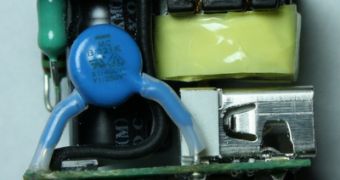iPhone chargers may be expensive, but Ken Shirriff says the technology crammed inside this small cube justifies some of that price, despite the high profit margins it offers for Apple.
After tearing down an iPhone adapter, Shirriff was pleasantly surprised to find that it had numerous parts and circuits inside to tinker with.
He analyzed them all and concluded that "Apple's power adapter is clearly a high-quality power supply designed to produce carefully filtered power. Apple has obviously gone to extra effort to reduce EMI interference, probably to keep the charger from interfering with the touchscreen.”
Shirriff explained that his initial expectations were to find a standard design, “but I've compared the charger to the Samsung charger and several other high-quality industry designs, and Apple goes beyond these designs in several ways,” he said.
“Apple's design provides extra safety in a few ways [...] the super-strong AC prongs, and the complex over-temperature / over-voltage shutdown circuit. Apple's isolation distance between primary and secondary appears to go beyond the regulations.”
“Apple's iPhone charger crams a lot of technology into a small space. Apple went to extra effort to provide higher quality and safety than other name-brand chargers, but this quality comes at a high cost,” he said, adding that he was “surprised to realize how enormous Apple's profit margins must be on these chargers.”
Apple’s charger sells for $30, whereas a similarly-designed Samsung charger sells for about $6-$10.
However, a commenter on Shirriff’s blog appropriately points out several factors that come into play to achieve the end product, further justifying Apple’s high price.
“Seeing how much thought went into these things, knowing a recall and a redesign happened, reading how the design goes above and beyond safety regulations, I dare assume Apple spent a lot of time on research, prototyping, and testing,” reader omegajunior explained.
“That time is an expensive investment and I'd say a large part of the margin goes into returning that investment. At some point, obviously, that ROI will be met and the remaining sales will turn into profit... part of which indubidably [sic] will be invested again for the next gadget,” omegajunior opined.

 14 DAY TRIAL //
14 DAY TRIAL //